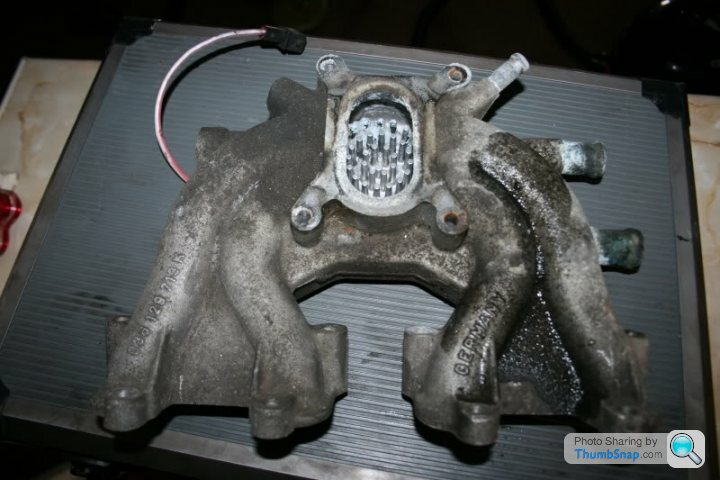Catch Can Advice
Discussion
Hi, this is my 1st post on here and I'm looking for some sound advice - hopefully, I'm in the right place!
I hope it's not too overkill, but I have a 1990 1.3 Mk2 Polo with some mild tuning mods (was 55bhp, now around 75-80bhp). It's no supercar, but just a bit of fun really.
I've swapped out the old Pierburg carb and factory air cleaner system and gone with a Weber DMTL and ITG foam filter.
This is sitting on the original manifold. - Now, on all RHD cars, there was no brake servo fitted due to space constraints, so this means the vacuum inlet/outlet on the manifold became redundant and was plugged at the factory via a pop rivet.
I have a Moroso oil catch can (it was a gift) I'd like to fit as a 'closed system' so I'm not venting into the atmosphere.
So...the question:
To run the vapor out feed from the catch can, can I utilise this redundant vacuum inlet/outlet as my vapor in feed line, missing out the carb?
Or...
Should I tap a feed-in on the ITG filter base plate, so the vapor goes through the carb?
Ideally, i'd like to create a clean install utilising the vacuum union, but don't know if it will work too well, or caused issues.
Any help, pointers appreciated and thanks in advance.
I hope it's not too overkill, but I have a 1990 1.3 Mk2 Polo with some mild tuning mods (was 55bhp, now around 75-80bhp). It's no supercar, but just a bit of fun really.
I've swapped out the old Pierburg carb and factory air cleaner system and gone with a Weber DMTL and ITG foam filter.
This is sitting on the original manifold. - Now, on all RHD cars, there was no brake servo fitted due to space constraints, so this means the vacuum inlet/outlet on the manifold became redundant and was plugged at the factory via a pop rivet.
I have a Moroso oil catch can (it was a gift) I'd like to fit as a 'closed system' so I'm not venting into the atmosphere.
So...the question:
To run the vapor out feed from the catch can, can I utilise this redundant vacuum inlet/outlet as my vapor in feed line, missing out the carb?
Or...
Should I tap a feed-in on the ITG filter base plate, so the vapor goes through the carb?
Ideally, i'd like to create a clean install utilising the vacuum union, but don't know if it will work too well, or caused issues.
Any help, pointers appreciated and thanks in advance.
Edited by lowrider76 on Sunday 26th April 09:22
stevieturbo said:
No you should not run the catch can to the intake vacuum.
Thanks for the reply - are you able to tell me the reasoning? What's the difference between it being sucked through the carb and it being sucked through the vacuum inlet on the manifold? It's still going to the inlet, just one before carb and one after carb.
Is the inlet vacuum going to be too much, by that I mean will it 'suck' too much?
The image below (courtesy of Google) shows the manifold. The vacuum port in question is the one on the top right:
Edited by lowrider76 on Sunday 26th April 11:44

Edited by lowrider76 on Sunday 26th April 12:14
lowrider76 said:
Is the inlet vacuum going to be too much, by that I mean will it 'suck' too much?
And unless the "catch can" has excellent oil/air separation, dont even bother re-introducing it into the intake at all.
And most generic catch cans are s
 te.
te.CrutyRammers said:
True dat. I've tried all sorts of things on mine, but it still leaks oil vapour like a steam train.
This is most likely true, but having something in place is gonna be better than nothing at all. The fact that you still get an element of leakage is why I want a closed system.This is the can:

it looks a bit small IMO from the picture,is it baffled inside?
ideally fit the biggest one you can(no pun)it allows the oil mist to cool and drop out quicker so reducing the amount of oil sucked back into the engine,same goes for connecting pipe size,larger bore equals slower gas speed again allowing more time for oil to drop.people wonder why their engine leaks oil from everywhere and they have tiny hoses for the breather system which will be restrictive when the engine is under duress.
as said you don't want it connected to the high vacuum side as you will use a lot of oil and any air leaks from a split or perished hose will upset the mixture and idle speed plus fitting a restrictor will be counterproductive and result in high crankcase pressure.
ideally fit the biggest one you can(no pun)it allows the oil mist to cool and drop out quicker so reducing the amount of oil sucked back into the engine,same goes for connecting pipe size,larger bore equals slower gas speed again allowing more time for oil to drop.people wonder why their engine leaks oil from everywhere and they have tiny hoses for the breather system which will be restrictive when the engine is under duress.
as said you don't want it connected to the high vacuum side as you will use a lot of oil and any air leaks from a split or perished hose will upset the mixture and idle speed plus fitting a restrictor will be counterproductive and result in high crankcase pressure.
Gassing Station | Engines & Drivetrain | Top of Page | What's New | My Stuff



